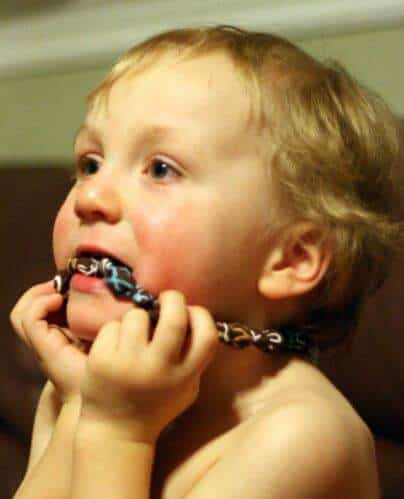Chewelry: Sensory Chew Toys for Your Child

If you are looking for an excellent way to keep your child with Autism, Sensory Processing Disorder, ADHD focused in the classroom or during homeschool lessons, you may want to consider incorporating chewelry to their learning experience. These sensory chew toys are a discrete, easy way to keep your child focused, and prevent behavioral and self-injurious behavior when they feel the need to fidget or chew.
Why Chewelry?
 Children with ADHD, Autism, and Sensory Processing disorder typically feel the urge to move frequently. If they are required to sit still for an extended period of time, it may result in them chewing or fidgeting.
Children with ADHD, Autism, and Sensory Processing disorder typically feel the urge to move frequently. If they are required to sit still for an extended period of time, it may result in them chewing or fidgeting.
Unfortunate, if given the chance, these children will chew on almost anything they can get their hands on. Many chew on pens, pencils and their fingernails. Since chewing on these items can be dangerous, it is important that we provide them with items that are more hygienic, and safer.
The items children use can range from fidget toys to sensory chew toys. They can be virtually anything that has different textures or provides a safe, soft, chewable surface. Companies have successfully met the needs of children and they have developed a large variety of options to choose from. The type of item used by children depends entirely on their personal method of coping with their internal force.
Common Behaviors Children with ADHD and Autism Experience
If you have a child with ADHD, Autism, or Sensory Processing Disorder who is fidgeting or chewing on different items, chances are they are using this behavior to curb the urge to move. Your child may chew on their pens, pencils, shirt, fingers, or other non-food items that are around them.
There are a lot of items you can use to replace their typical chew items. These items are safer for children and a lot cleaner than things their hands come into contact with frequently. Finding the right item for your child is important. If you have tried fidget items and are not seeing the results you would like, try adding chewlery to your child's fidget items.
Helping Children with ADHD and Autism
As a parent, you would do almost anything to keep your child from getting teased for their behavior or being bullied because of it. Sadly, children with ADHD, Autism, and Sensory Processing Disorder are commonly teased because of their urge to chew on non-food items.
Chewing on non-food items draws unnecessary attention to themselves from other students/kids and even teachers.
Providing discrete items to fidget with allows them to satisfy their urge to move their hands and feet, or even their body without drawing attention to themselves. These items reduce the urge to move their entire body and allow them to move just enough to satisfy their urges to move around.
Along with fidget items, you can provide them with occupational therapy sensory chew toys that satisfy their urge to chew on non-food items.
Types of Sensory Chew Toys

Sensory chew toys come in many different styles. The most popular type of sensory chew toy on the market today is the necklace. These chews are discrete and look like every day, age appropriate jewelry. The difference is that your child can chew on it to help control the urge to move and chew.

Other popular sensory chew toys are P-shaped, Q-shaped and T-Shaped chews.
They allow your child to chew on a small area, or a large area, depending on the amount of tension they need to release, or the amount of movement they crave at the time.
Make sure to browse through the growing Chewlry section on Etsy.
Research Supporting Sensory Chew Toys
We know sensory chews are a very popular item for children with ADHD, autism, and sensory processing disorder, but does research support their use?
Research shows that children with these conditions who use sensory chew toys experience a calmer, more focused learning experience. Researchers think that stimulating the trigeminal nerve, which runs from the jaw to the brain stem, is the reason why these sensory chews relieve stress. This nerve has minor control of the awake/sleep cycle. However, when you trigger it in stressful situations, it has the ability to calm and soothe.
What do Dentists Say About All this Chewing?
Unfortunately, dentists are not as excited about the addition of sensory chew toys as occupational therapists and teachers are. According to dental research, sensory chew toys are not off-limits, but they should be used conservatively.
A child who is easily aggravated may chew on their sensory items for too long. A child who chews vigorously for an extended period of time daily, over a year's time can cause significant damage to the roots of their teeth.
With the increase in ADHD, Autism, and Sensory Processing Disorder diagnoses has come an increase in the number of children diagnosed with shortened dental roots. Over time, shortening these roots can damage the stability of the teeth, resulting in eventual premature tooth loss. This is even the case in situations where the child has only permanent teeth. Once permanent teeth with shortened roots have been lost, they cannot be replaced and the child will require a partial.
To prevent damage to the roots of teeth, chewing should be limited to 30 minutes per day, split into multiple sessions so the gums have time to recover.
Children with the urge to move, and children who need to chew on something to soothe themselves, will greatly appreciate the addition of sensory chew toys in their school life. If your child has an IEP, these items will not only be allowed in class, it is also mandatory for the school to provide these items, so you do not have to worry about paying out of pocket for items used at school. Take advantage of the relief your child will experience after they are added to their daily school life.
Don't stop here! There's more:
From Our Home to Yours
See more Reviews






